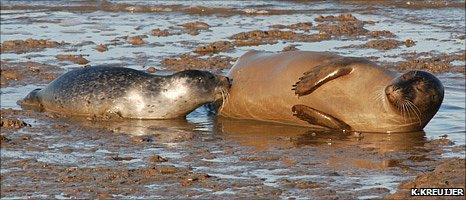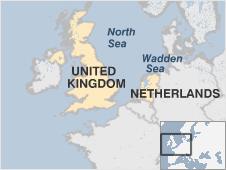Harbour seals 'pupping earlier'
- Published

The study suggests that improved access to food has triggered the earlier births
Harbour seals are giving birth to pups earlier each year as a result of changes to the marine ecosystem, a study has shown.
It said the mammals, also known as common seals, were being born 25 days earlier compared with 35 years ago.
Scientists suggested the removal of large fish species by fishing boats was allowing populations of smaller species - favoured by the seals - to thrive.
The findings appear in the Royal Society journal Biology Letters.
"We report on a continual shift in the birth date of harbour seals in the Dutch Wadden Sea," the team of researchers from the Netherlands Institute for Marine Resources and Ecosystems Studies (IMARES) wrote.

"Given the similar results found for harbour seals (Phoca vitulina) in other parts of the Wadden Sea, we conclude that the factor causing this shift has acted on the entire... population."
It is understood that the mating season runs from spring until autumn. Males may mate with more than one female, and females give birth to one pup in the spring, about 9-11 months after mating.
Gestation includes a period of delayed implantation, when the fertilised egg stops growing and floats in the female's uterus for one-and-a-half to three months.
The delayed implantation allows the mother to recover from her last pregnancy, and it also allows the pup to be born when conditions are best suited for its survival.
'Fat threshold'
"A possible mechanism for this shift in pupping could be a shortening of one or several stages in the reproductive cycle, including lactation, delayed implantation and placental gestation," the team wrote.
Older females tend to give birth earlier in the year, but the team found that there had not been a noticeable change in the age structure of the seal populations, which allowed them to rule this out as a possible reason.
The scientists then investigated whether there had been a shift in the placental gestation period, but found there had been no noticeable variation in this stage of the reproduction cycle.
However, the team said previous research into harp seals (Pagophilus groenlandicus) had identified a link between the females' condition and implantation dates.
"We therefore suggest earlier timings of implantation as the most likely mechanism explaining the observed shift," the researchers added.
"Possibily, nutritional condition of mother after lactation... is of importance."
Females undergo rapid weight loss during the weaning and mating seasons, leading the researchers to suggest that the animals needed to "acquire a fatness threshold prior to implantation".
"In other words, the better the food acquisition during and after lactation, the earlier they regain the mass needed for implantation," they explained.
The favoured prey of the seals are a variety of small, bottom-dwelling fish species.
The scientists said surveys in the North Sea revealed that the abundance of small fish had "increased steadily and significantly from 1977".
"Intense fishing of larger fish in the North Sea has caused both a shift to smaller species and a decrease in larger predator fish, hence predation on small fish has decreased," they said.
As a result, they suggested that this had led to an increase in the amount of prey available to the seals, allowing the females to reach the "fat threshold" more speedily and shortening the period of delayed implantation.
"This [hypothesis] is supported by the increase in avian predators specialising on similar small prey," the researchers added.
"It is interesting to see whether this shift (in delayed implantation) might be reversed when this exponentially growing (seal) population approaches the carrying capacity of the area."